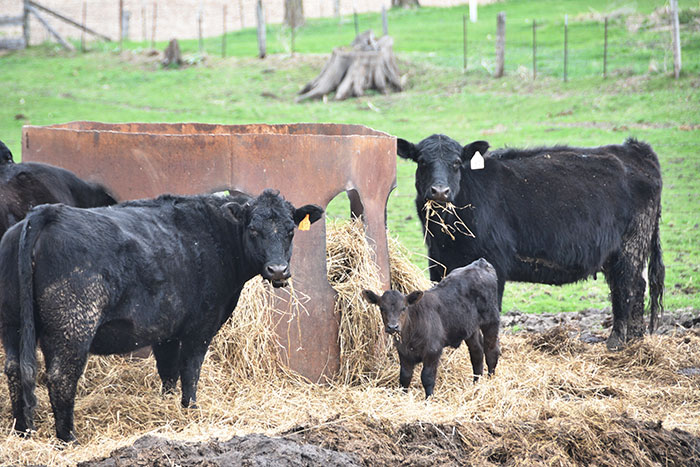Minimize pasture damage from winter feeding |
| By Michaela King |
|
|
|
Winter feeding often results in damage to pastures — but taking a few preventative measures will reduce the damage, mitigate erosion, and encourage better forage growth in the spring. “There is not a ‘one size fits all’ answer to reducing pasture damage during winter feeding,” according to Jessica Williamson, an extension forage specialist with Penn State University. “Each individual producer should analyze his or her operation and determine if there are small steps that they can take to reduce the damage incurred annually while feeding in the winter.” In a recent blog post, Williamson offers the following strategies for minimizing pasture damage this winter or into the future. 1. Create a sacrifice pasture or lot. Designate an area to be used during bad weather conditions to save other pastures from damage. During the late fall, winter, and early spring, offer stored feedstuffs in these designated areas until there is enough growth for the pastures to be grazed. 2. Divide the designated area into sections. Splitting the sacrifice area into multiple sections allows for additional control over where livestock can be during winter feeding. By splitting an existing area into smaller sections, changes in weather patterns and precipitation can be minimized by confining the livestock in a muddy area, then allowing them to get to a new, undamaged area after the ground freezes or dries. 3. Lure livestock by feeding. Change where the hay feeders, mineral feeders, or feedbunks are located in the sacrifice pastures. This encourages livestock to go to different and unpopular parts of the paddock. It also reduces damage and mud accumulation in the more popular and heavily traveled areas. 4. Try bale grazing. Feeding livestock with rolled-out hay reduces high traffic at hay feeders and also helps with nutrient distribution in the soil. Additionally, it gives livestock a better opportunity to choose the highest quality forage from the bale while feeding. However, bale grazing leads to a large amount of forage waste, around 15 to 50 percent, depending on the quality of the hay, the amount available for consumption, and grazing habits. The best time to utilize this strategy is when feed resources are plentiful and forage quality is low. “It can also be used in combination with other feeding techniques, such as feedbunks or ring feeders that are being used to feed the higher quality forage,” Williamson notes. 5. Reduce waste with hay feeders. Using ring feeders or feeding ground hay in bunks leads to less waste, and the feeders can be moved around the designated area to reduce mud and damage in one area of the pasture. Additionally, placing the feeder on a concrete slab allows for mud and manure to be easily removed. Feeders result in less waste, but, if not moved, they can cause more pasture damage over time. 6. Stockpile forage for deferred grazing. A good way to extend the grazing season and feed higher quality forage than harvested crops is by stockpiling pasture forage. It also limits the damage to pastures and the sacrifice lot. Applying nitrogen and then allowing growth 70 to 90 days prior to the end of the fall growing season maximizes forage accumulation for winter grazing. Use a strip grazing technique to fully utilize the stockpiled forage and to minimize trampling and waste. Remember that the forage still needs to regrow in the spring, so maintain a minimum 3-inch residue height. 7. Choose hardier species for winter pastures. Forage species that withstand harsh and less than ideal conditions, have dense root systems, and have a high tolerance to frequent grazing perform best as winter pastures. Tall fescue and Kentucky bluegrass are examples of cool-season species that fit this description, Williamson notes. 8. Feed on concrete or structured feeding pads. When feeding on concrete or another hard surface, manure and urine are concentrated in a centralized area and the nutrients are easier to remove. Additionally, if livestock have a dry area for leisure and bedding, the benefit of using concrete rises. Looking ahead “Following winter feeding, reseeding severely damaged sacrifice pastures that have been severely damaged with annual forages is an excellent way to optimize forage production in that area, while also suppressing weed pressure,” Williamson explains. “Planting a warm season annual like sudangrass, sorghum-sudangrass, or pearl millet directly into your sacrifice pasture will allow the opportunity for pasture productivity from an otherwise low-producing field due to the winter damage it incurred." With careful management and the right planning, damage caused by winter feeding can be reduced. Analyze past winter issues and assess the different options for preventing severe pasture damage this winter.  Michaela King Michaela King served as the 2019 Hay & Forage Grower summer editorial intern. She currently attends the University of Minnesota-Twin Cities and is majoring in professional journalism and photography. King grew up on a beef farm in Big Bend, Wis., where her 4-H experiences included showing both beef and dairy cattle. |

